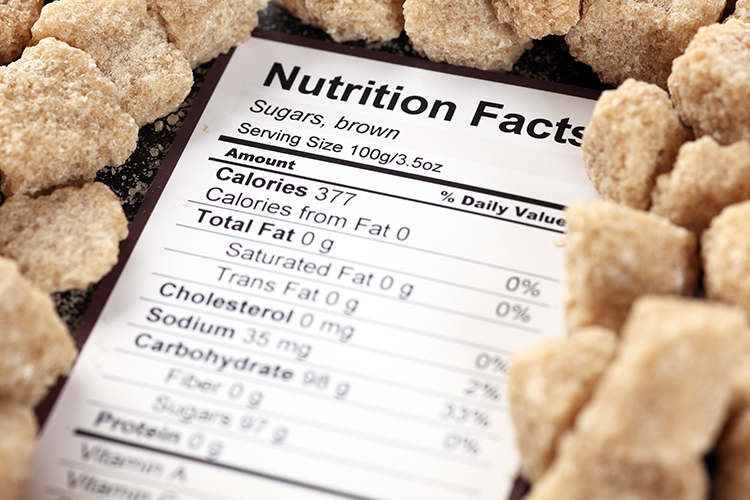Blog
Some ins and outs of adding added sugars to labels
 So, the Food and Drug Administration (FDA) in the U.S. is requiring food manufacturers to list the amount of added sugars to the nutrition information panels of their products by July 2018.
So, the Food and Drug Administration (FDA) in the U.S. is requiring food manufacturers to list the amount of added sugars to the nutrition information panels of their products by July 2018.
This is a pretty big undertaking and one we would love mirrored Australia.
Why?
Added, or free, sugars lurk in around 80% of the processed or packaged foods and drink on our supermarket shelves. It can be in obvious foods, like lollies, ice cream or soft drink, but there are surprisingly high amounts in unexpected places, like soups, flavoured yoghurt, breakfast cereals and muesli bars.
Now, don’t get us wrong. A little added sugar is fine. The FDA is setting the percent Daily Value (%DV) to 50g (or 10% of overall energy intake) per day. We endorse recommendations of the World Health Organisation to limit to 25 grams (6 teaspoons) per day for health benefits.
Despite efforts to limit the number of cookies, or slices of office birthday cake, or teaspoons of sugar in your coffee, when we often don’t realise where the sugar lies (like in seemingly healthy foods) consumption can add up over a day, a week, a year, a lifetime.
And too much of the sweet stuff may contribute to type 2 diabetes, cardiovascular disease, non-alcoholic fatty liver disease and obesity, as well as have an everyday impact affecting sleep, cognition, memory and mood.
So, a big undertaking it may be. But overconsumption is becoming a public health issue, and adding added sugars to nutrition panels is required to assist us in making informed choices about what we eat and drink.
Looking at a Q&A as part of draft guidelines recently published, here is a brief overview of several of the requirements by the FDA as to what kind of parameters there are for declaring and separating out added sugar content.
Who is responsible for the accuracy of the Nutrition Facts label on a food product’s label? Who is responsible for maintaining the records needed to verify the accuracy of certain nutrient declarations?
It is up to the food manufacturer or a private labelling company to ensure the information on the nutrition information panel and nutrient claims are truthful and accurate. The records for such information are to be created and kept by the manufacturer.
Do sugars found in fruits and vegetables that have been processed to change the form of the fruit or vegetable (e.g., concentrated fruit and vegetable purees, fruit and vegetable pastes, and fruit and vegetable powders) need to be declared as added sugars on the label?
According to the FDA, if the amount of sugar in a paste or puree, for example, does not exceed the amount of sugar one would get naturally from the same amount of fruit and veg prior to being processed, and you retain all the goodies like fibre, it is not an added sugar.
If goodies like fibre are removed when fruit or veg are processed and the sugars are concentrated, the sugar is added.
The definition of added sugars excludes the “fruit component of fruit spreads.” What constitutes the “fruit component” of a non-standardized fruit spread?
This is what the FDA state, pretty clearly, verbatim:
“The fruit component of a fruit spread would include whole fruits, pieces of fruit, dried fruit, fruit purees (that have not been concentrated), fruit pulps, single-strength fruit juice, or other fruit ingredients where a whole fruit has been processed so that the plant material is physically broken down into smaller pieces (e.g., chopping, dicing, grinding, pureeing, etc.) but the sugar in the ingredient has not been concentrated.”
The regulation says in 21 CFR 101.9(c)(6)(iii) that added sugars are a “statement of the number of grams of added sugars in a serving, except that label declaration of added sugars content is not required for products that contain less than 1 gram of added sugars in a serving if no claims are made about sweeteners, sugars, added sugars, or sugar alcohol content.” What does FDA consider to be a “sweetener?” Do sweeteners include sugar alcohols and other low-calorie sweeteners?
The FDA considers both caloric and non-caloric sweeteners, including sugar alcohols, to be sweeteners. If a product is going to make some label claim about being sugar-free, then the sugar serving amount must be listed, even if it is a teeny amount.
Do sugars present in a sweet fermented beverage after fermentation need to be declared as total or added sugars on the label?
Added sugar amount should be based on what is present in the end product. If there is residual sugar from a sweetener added during the fermentation process, it needs to be declared in total and added sugars.
Want more? See here for other questions and answers, and the nitty gritty details on the above.
As Marion Nestle pointed out when writing on this subject, “The elephant in the room? Will the new administration step in and repeal the whole thing?”
We will have to wait and see.
By Angela Johnson (BHSc Nut. Med.)











